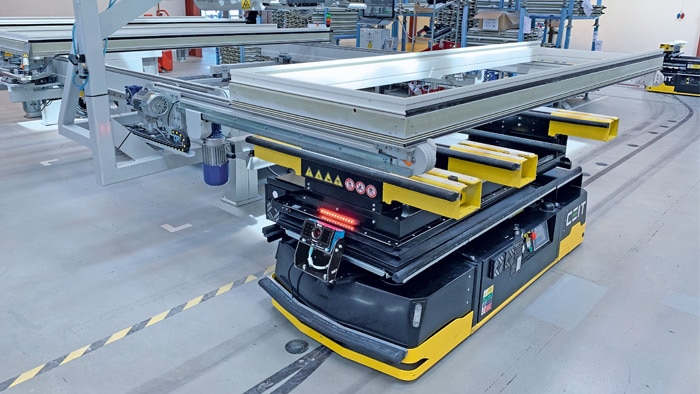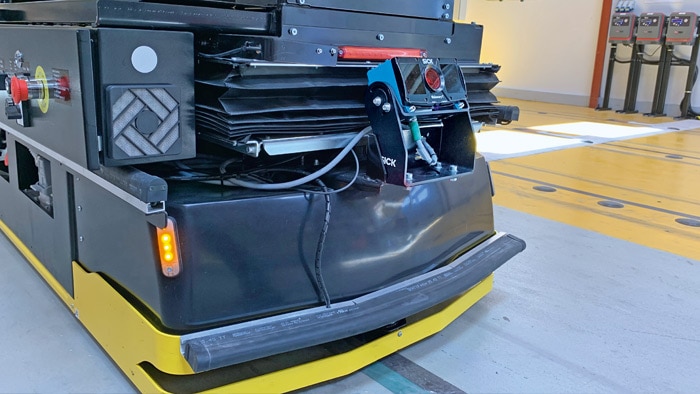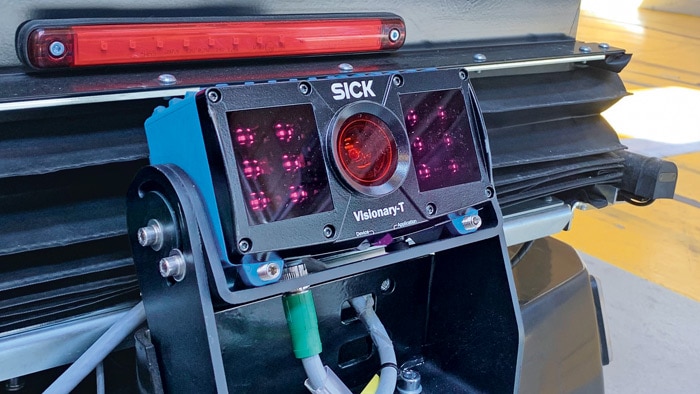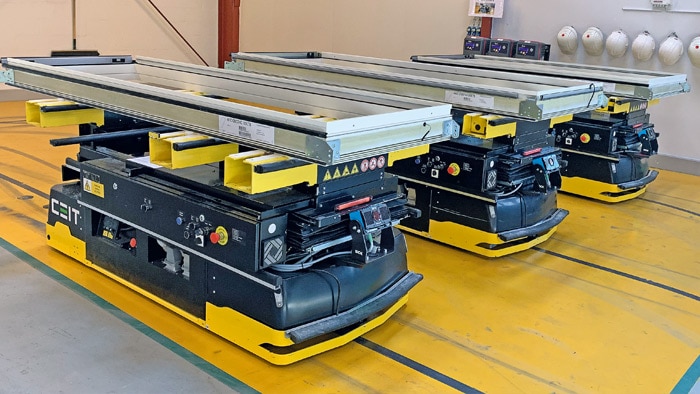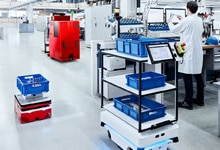The future is here: Industry 4.0 applications are concrete and already a reality. Mobile platforms and their reliable control are an important part of this development. Automated guided vehicles, AGVs for short, are conquering more and more of the production halls and warehouses of this world. The automated vehicles must learn to “see” to prevent collisions. CEIT, the Slovakian partner from SICK, is using the Visionary-T DT for this purpose. This 3D vision camera detects collision risks in pre-defined three-dimensional spaces even if the light conditions are bad. For example, dark obstacles which are protruding into the travel path are also reliably detected.
AGVs from CEIT use Visionary-T from SICK for collision protection
Automated guided vehicles must be able to react flexibly to obstacles in difficult situations and light conditions to ensure smooth 24/7 operation with a high degree of productivity. Versatile yet rugged sensors are essential for this. With the intelligent Visionary-T DT 3D vision camera from SICK, CEIT has found a mobile 3D vision system which optimally fulfills these requirements.
A real stroke of luck for both companies which are both considered extremely innovative in their areas: SICK for sensor intelligence for industrial applications and CEIT for the automation of internal logistics. This led to a collaboration of equals which both partners can do nothing but praise.
Detect objects with “snapshots” even in dark corners
The Visionary-T DT operates on the principle of time-of-flight measurement. The 3D vision camera mounted on the vehicle detects a large area in front of the AGV with its three-dimensional detection volume. To capture an image, the Visionary-T DT sends a light signal in the direction of the measuring object.
“The snapshot camera uses the 3D time-of-flight technology to detect information in real time and create a complete 3D image of the area in the direction of travel of the vehicle. AGVs can therefore see objects on or above the floor and react appropriately”, explains Jan Donoval, Product Manager at SICK Czech Republic. The sensor receives the reflected light for each pixel, and calculates the distance between the camera and the measuring object based on the phase shift. Different phase shifts equate to different distances. Accordingly, thousands of pixels captured in a single shot, a 3D point cloud, deliver a detailed image of the entire field of vision. This three-dimensional distance image is also called a 3D snapshot. Nearly every object surface is therefore detected. These “snapshots” reliably prevent collisions with various objects such as racks, other machines or people. Thanks to the high-performance illumination elements, this also happens under extreme light conditions as well as in darkness and prevents the vehicle from colliding with protruding or hanging objects.
Configuration for reliable use
The snapshot camera from SICK can be configured according to the customer requirements using the delivered software. Discrete input signals can be used to change between different configurations. The sensor can therefore be adjusted very quickly to different ambient conditions. Michal Lorencovič, Electric Designer at CEIT, explains it this way: “To cover the relevant 3D volume in front of the vehicle, the 3D detection zone was divided up into several detection groups, which results in a graduated delay behavior. For example, we can quickly change between a configuration for pathway travel and for curves using the discrete inputs.” The focus was on fault-free object detection for an application in an AGV from CEIT. Various special image processing filters were developed to improve the 3D image data quality and detection algorithms to prevent faulty alarms and vehicle stops. The spatial position of dark, half-transparent or reflective objects can be detected even at large distances with up to 30 images per second. This prevents collisions as well as unnecessary stops, enabling interruption-free operation of the automated guided vehicle systems. This is efficient and increases productivity. But the Visionary-T DT can do even more. In addition to the finished evaluation of the 3D data for purposes of collision warning and detection directly on the camera, the complete 3D data is also available via TCP/IP along with the sensor responses. The raw 3D data can be used in parallel for other solutions while collision warnings can be output via the discrete outputs as simple sensor responses. Information tailored to the respective application.
But the Visionary-T DT can do even more. In addition to the finished evaluation of the 3D data for purposes of collision warning and detection directly on the camera, the complete 3D data is also available via TCP/IP along with the sensor responses. The raw 3D data can be used in parallel for other solutions while collision warnings can be output via the discrete outputs as simple sensor responses. Information tailored to the respective application.
Excellent performance
With the different variants of the Visionary-T, SICK has launched an extremely competitive camera solution on the market for mobile platforms. A market which will surely grow significantly in the next few years and which is full of big players. Including CEIT and SICK with their industry solutions. “For CEIT it is a great success to cooperate with the VW group as a customer as it shows that such innovations are not only accepted but actually required by big companies,” Dr. Fabian Zimmer, application engineer at SICK, summarizes. “We are constantly working on new developments such as high-resolution 3d snapshot cameras. The earlier innovative companies such as CEIT are involved, the easier it is to consider customer requirements.”
The AGVs from CEIT, now equipped with the Visionary-T DT, are impressing many new clients. For them, the collision avoidance solution in automated guided vehicles means less production downtime in their factories. In addition to Škoda, for example the renowned skylight manufacturer VELUX is another happy customer of CEIT.
Impressive proof of excellent performance.
Read more:
Innovative intralogistics: AutoBox with SICK navigation and safety sensors in pilot test at BMW
Visionary-B 3D assistance system prevents accidents when driving backwards
Complete sensor solutions for AGC systems in CEP distribution centers
Automated production logistics with automated guided vehicle systems
Volker Glöckle
Vice President and Head of Global Industry Center Technical Industry Management
Since joining SICK in 2001 Volker Glöckle has held various leading positions in operative logistics. Currently he is in charge of reference projects in the field of mobile vehicles and carts and works together with customers on the development of a "digital twin" for logistic systems.
Industry 4.0 is picking up speed: Automated flexibility for mobile vehicles and carts
Our modular solutions portfolio for mobile platforms now makes it possible to implement line guidance, navigation, positioning, environmental recognition, security and load handling with ease.
I want to stay up to date and regularly be informed about new articles!
